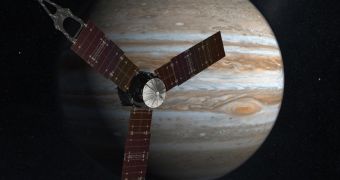Experts at the Astrotech processing facility, in Titusville, Florida, announce that the complete propulsion system of the next NASA mission to the gas giant Jupiter has been fully integrated, tested, and is now ready to fly.
The Juno mission will launch later this year, and its main mission is to study the giant planet while performing 33 orbits around Jupiter. During this time, its advanced suite of scientific instruments will conduct a wide range of studies on the planet, its atmosphere, magnetosphere, and so on.
Engineers say that the propulsion system was completed earlier this week, after the hydrazine fuel was loaded into the spacecraft, and the oxidizer material was added in as well. Finally, the entire fuel tank was then pressurized, and the system deemed ready to fly.
Juno is now about 99 percent ready to launch. Experts say that there are only processes that still need to be completed. The first is completing the final thermal blanket closeouts, while the second one is putting the entire spacecraft through a series of wet spin tests.
After these assessments are completed, the Juno orbiter will receive its mission approval, and will be ready for integration with the Atlas 551 delivery system that will take it to Earth's orbit. The spacecraft will take off from the Cape Canaveral Air Force Station (CCAFS), in Florida.
Engineers say that hydrazine was selected as a fuel for Juno because of the amounts of energy this chemical can store. These vast volumes of energy can only be unlocked when the hydrazine is mixed with the oxidizer chemical.
Once this happens, “the liquid ignites in the propulsion system's main engine to perform the spacecraft's four large maneuvers,” reads a press release from the NASA Jet Propulsion Laboratory (JPL), in Pasadena, California.
“Once we get Juno into space, it's a five-year cruise to Jupiter. The launch window is the length of time allotted every day for an attempt to launch the spacecraft,” say JPL Juno project manager Jan Chodas.
The JPL manages Juno as part of the New Frontiers Program, which is led by experts at the NASA Marshall Space Flight Center (MSFC) in Huntsville, Alabama. The principal investigator of the mission is Southwest Research Institute (SwRI) expert Scott Bolton.
Overall, Juno will help experts get more insight into the structure of the Jovian atmosphere, on the electromagnetic phenomena taking place at the two poles, into the magnetosphere, auroras and so on.

 14 DAY TRIAL //
14 DAY TRIAL //